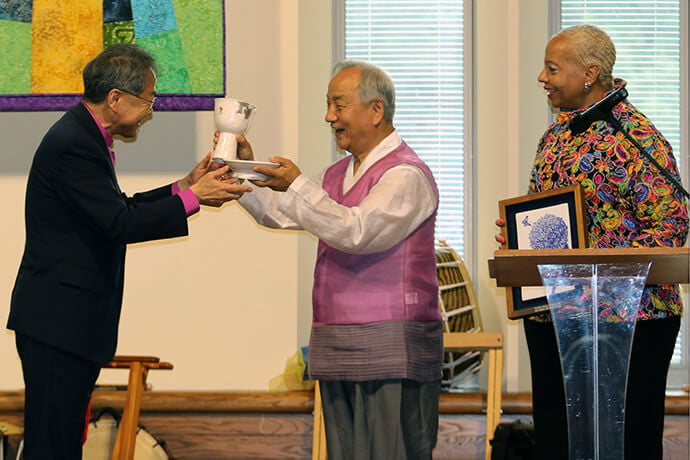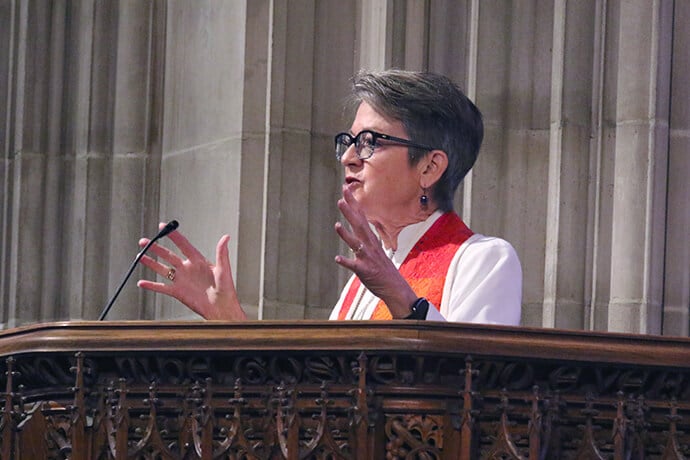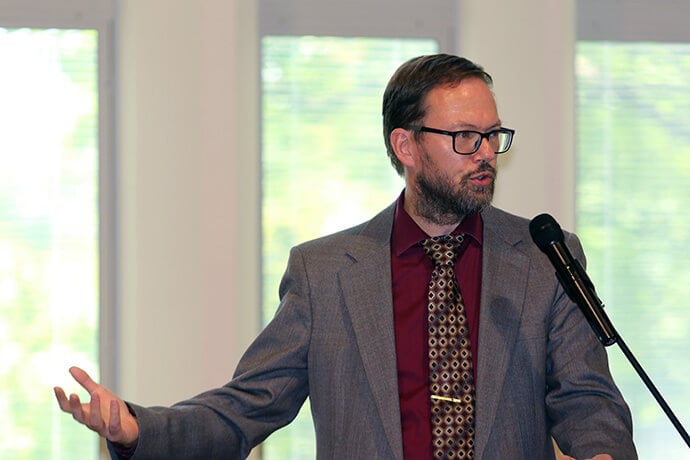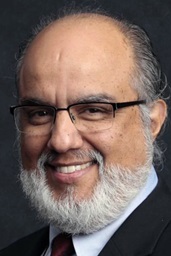Key points:
- The event was part conference, part worship celebration and part family reunion of two denominations with intertwined histories.
- Pioneering missionaries Mary and William Scranton had been sent from Ohio to Korea in the late 19th century, planting seeds that would grow into thriving ministries of education, health care and Christian witness.
- Bishop Tracy S. Malone led opening worship and challenged attendees to run toward mission, justice and unity.
For three days, the sanctuary of Church of the Saviour United Methodist Church in Cleveland Heights, Ohio, became a crossroads of history, faith and mission.
Clergy, scholars, denominational leaders and descendants of pioneering missionaries Mary and William Scranton gathered Aug. 4-6 to honor the 140-year legacy of Methodist mission in Ohio, Korea and beyond.
The event — organized in collaboration with the Ohio Episcopal Area of The United Methodist Church, the Korean Methodist Church, United Methodist Board of Global Ministries, United Methodist Commission on Archives and History, Korean Ministry Plan, Korean Association of The United Methodist Church, and a member of the Scranton family — was part conference, part worship celebration and part family reunion of two denominations with intertwined histories.

It was also a deeply personal homecoming. The Scrantons had been sent from Ohio to Korea in the late 19th century, planting seeds that would grow into thriving ministries of education, health care and Christian witness.
Mary F. Scranton, originally from Massachusetts, arrived in Korea in 1885 under the appointment of the Woman’s Foreign Missionary Society of the Methodist Episcopal Church. Though she had previously lived in Japan and found life there comfortable, her heart belonged to the Korean people.
“Life in Japan is enjoyable, and the living conditions for missionaries are excellent,” she once said, “but I want to go to my people (the Koreans) and live among them.”
Mary’s life and ministry in Korea were groundbreaking. In 1886 she founded Ewha Hakdang (now Ewha Womans University), opening unprecedented educational opportunities for women in a society where Confucian traditions had severely restricted them. She also established Bogu Yeogwan, the first women’s hospital in Korea, integrating medical care with education and Christian compassion.
Mary had claimed that she would die in Korea, and she was true to her words. She served until her death in 1908, resting now at the Yanghwajin Foreign Missionary Cemetery in Seoul.
Her son, Dr. William Benton Scranton, who trained at Yale University and New York Medical College, arrived in Seoul in May 1885. He opened a public clinic in Jeong-dong and, realizing the barriers the poor faced in traveling there, established Good Samaritan’s Hospital outside the city’s gates in 1888. This facility not only treated the sick but became a locus for community life — its legacy living on in Ahyeon Methodist Church.

The conference began with an opening worship service led by Bishop Tracy S. Malone, who oversees the Indiana Episcopal Area and serves as president of the United Methodist Council of Bishops. Her sermon, “Forward Through the Ages,” challenged attendees to run toward mission, justice and unity.
“Why do we run?” Malone asked. “Because Mary and William Scranton ran to bring the gospel. Because Methodists before us ran with perseverance. Because Korean Methodists are still running. The mission of God is not behind us — we celebrate legacy tonight, but God’s mission is always in front of us, leading us. The Spirit is still moving, Christ is still calling, and the gospel is still good news to the brokenhearted.”
With that call, Malone invited participants to thank God “for still sending, still calling and still leading us.”
During morning worship the following day, retired Bishop Sally Dyck reflected on Mary Scranton’s revolutionary influence on Korean women’s education and rights. She reminded listeners that Scranton mentored Yu Gwan-sun — who was later revered as Korea’s “Joan of Arc” — and urged the church today to ask whether it still empowers girls and women to fully use their God-given gifts.
“When Mary Scranton started Ewha,” Dyck said, “she sowed seeds to transform women’s lives, Korea and the world.”

Later that day, Commission on Archives and History top executive Ashley Boggan highlighted the critical role of laywomen in sustaining Korean Methodism’s growth.
“With or without ordination, women led the way,” Boggan said, noting that the Wesleyan tradition of mission through education and health care continues to bear fruit globally.
Bishop Chung-Suk Kim, president of the Korean Methodist Council of Bishops, preached from John 12:24-25 on the sacrificial nature of the Scrantons’ ministry. From the first student at Ewha Hakdang to the thousands of Korean Methodist congregations today, Kim traced a direct line from Mary Scranton’s work to the church’s global mission presence.
“Just as a grain of wheat dies and bears much fruit,” Kim said, “the gospel Mary Scranton preached gave birth to new hope in Korea.”
Throughout the conference, plenary sessions brought academic depth to the celebration.
David W. Scott, senior director of Theology and Strategic Planning for the Board of Global Ministries, offered a historical framework for the evolving relationship between the Korean Methodist and United Methodist denominations — from a “mother/daughter” dynamic to “older/younger sisters” and, today, to peers and partners.
The Rev. Young-Suk Suh, professor of Hyupsung University in Korea, described the Scrantons as “makers of history” whose ministries helped lay the foundations for democracy and civil society in Korea, while the Rev. Hwa-Young Chong, a Northern Illinois district superintendent, emphasized Scranton’s embodiment of “social holiness,” integrating evangelism with education, health care and justice.
The Rev. Dr. Lee-Ellen Strawn of Northfield Mount Hermon in Gill, Massachusetts, explored Mary Scranton’s creation of the Bible Women system — an initiative empowering unordained female evangelists whose work would ripple through Korean society for decades.
Subscribe to our
e-newsletter
While most presenters focused on Mary Scranton, the Rev. Heung-Gyu Kim, senior pastor of Naeri Methodist Church, Incheon, Korea, recounted the life and legacy of William Scranton, reframing him not as a “tragic elite missionary” but as “a missionary to the masses,” deeply engaged with the poor and humble.
Several speakers turned the lens toward the future.
The Rev. Changmin Lee, pastor of Zion Korean United Methodist Church and president of the Korean Association of The United Methodist Church, urged a bold, mutual partnership between Korean Methodists and United Methodists: “Let us invest in mutual mission as we would in a mutual fund — trusting God to multiply what we offer.”
Ohio Area Bishop Hee-Soo Jung, whose own faith journey began in communities planted by the Scrantons, reflected on William’s role in conflict resolution and revival movements in early 20th-century Korea.
“Scranton became a grain in Korean soil for the gospel of Jesus Christ,” he said. “We remember and give thanks for their unconditional dedication to Methodist mission.”
Preaching the closing worship service, retired Bishop Jeremiah Park anchored his message in Acts 13:47.
“If you asked Mary and William Scranton why they left everything to go to the ends of the earth,” Park said, “I believe they would say, ‘Love made us do it.’”
For many attendees, the conference was more than a commemoration; it was a personal affirmation of calling.
The Rev. Clara Kwon of Sharonville United Methodist Church in Cincinnati described herself as “a fruit of United Methodist missionaries.” She saw the event as “an opportunity to honor the debt we owe for the sacrifices in bringing Methodism to Korea.”
The Rev. Byung-Bae Hwang, top executive of the General Board of Mission of the Korean Methodist Church, called the gathering “God’s providence,” expressing hope that it would renew the relationship between Korean Methodists and United Methodists. He revealed plans to dedicate the William Scranton Memorial Church in Korea next year and to invite U.S. partners to join the celebration.
In worship, in lectures, and conversations over coffee, participants returned again and again to the enduring power of the Scrantons’ example: faith integrated with service, sacrifice rooted in love, mission inseparable from justice.
In the 140 years since they departed from Ohio to an unfamiliar peninsula, the seeds Mary and William Scranton planted have grown into a rich harvest: a vibrant Korean Methodist Church, a global United Methodist witness, and a continuing partnership that promises new fruit for generations to come.
Bishop Jung summed it up: “As we listened to and embraced the lives of Mary and William Scranton, we were also creating a new story. This is the most urgent time for us to gather and unite through mission.”
Kim is director of Korean and Asian news at United Methodist Communications. Contact him at 615-742-5470 or [email protected]. To read more United Methodist news, subscribe to the free UM News Digest.




